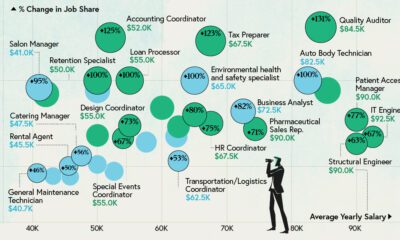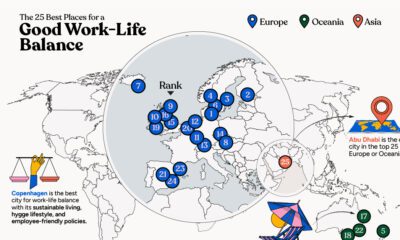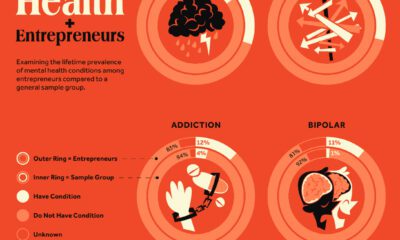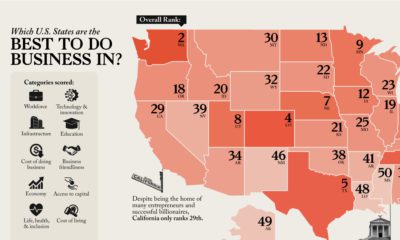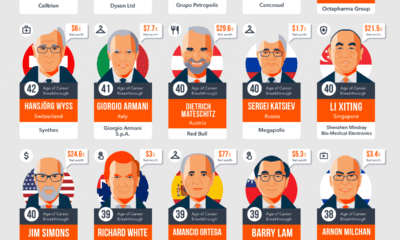Misc
Emotional Intelligence: A Hidden Key to Career and Workplace Success
When the term “intelligence” comes up in regular conversation, most of us associate it with a person’s capacity to acquire knowledge and new skills.
This type of intelligence can be measured with IQ, which helps us determine if the test taker is closer to a Stephen Hawking or a Lloyd Christmas on the smarts scale. And certainly, given no other data, a hiring manager would likely prefer to choose someone on the Hawking end of the spectrum.
But while IQ is useful, it’s also clear that emotional intelligence (EQ) can be a difference maker in any professional role.
Defining Emotional Intelligence
Have you ever met an entrepreneur with so much empathy and awareness, that they can read people in every situation and relate? Or a salesperson that will always genuinely put your success ahead of their own personal gain?
These are powerful qualities – and emotional intelligence is all about the ability to better navigate social situations, including with colleagues, bosses, and clients.
Today’s infographic comes from Aumann Bender & Associates, and it defines emotional intelligence while explaining the benefits of higher EQ in both qualitative and quantitative terms.

Even if someone is smart in terms of IQ, it doesn’t necessarily translate to career success.
In fact, emotional intelligence explains why 70% of the time, a person with an average IQ can actually outperform a person with more smarts.
Quantifying EQ
Although the topic of emotional intelligence may seem “touchy-feely” for some, the benefits of having a higher EQ are cold, hard facts to ponder:
- A whopping 90% of top performers have high EQs
- Emotional intelligence explains 58% of a leader’s job performance
- People with higher EQs make an average of $29,000 more per year than people with lower EQs
- Every one-point increase in EQ equates roughly to $1,300 in annual salary
- Research shows that EQ is crucial across all industries and sectors
So the next time you’re looking at how to get an edge at the workplace, consider that it’s not just knowledge or skills that you should be after.
Sometimes there is a higher ROI in the “soft skills”: being more self-aware, learning how to effectively express your opinions or emotions, finding ways to bounce back from adversity, or managing stress or negative emotions can be more important than technical skills in improving career performance.
VC+
VC+: Get Our Key Takeaways From the IMF’s World Economic Outlook
A sneak preview of the exclusive VC+ Special Dispatch—your shortcut to understanding IMF’s World Economic Outlook report.

Have you read IMF’s latest World Economic Outlook yet? At a daunting 202 pages, we don’t blame you if it’s still on your to-do list.
But don’t worry, you don’t need to read the whole April release, because we’ve already done the hard work for you.
To save you time and effort, the Visual Capitalist team has compiled a visual analysis of everything you need to know from the report—and our upcoming VC+ Special Dispatch will be available exclusively to VC+ members on Thursday, April 25th.
If you’re not already subscribed to VC+, make sure you sign up now to receive the full analysis of the IMF report, and more (we release similar deep dives every week).
For now, here’s what VC+ members can expect to receive.
Your Shortcut to Understanding IMF’s World Economic Outlook
With long and short-term growth prospects declining for many countries around the world, this Special Dispatch offers a visual analysis of the key figures and takeaways from the IMF’s report including:
- The global decline in economic growth forecasts
- Real GDP growth and inflation forecasts for major nations in 2024
- When interest rate cuts will happen and interest rate forecasts
- How debt-to-GDP ratios have changed since 2000
- And much more!
Get the Full Breakdown in the Next VC+ Special Dispatch
VC+ members will receive the full Special Dispatch on Thursday, April 25th.
Make sure you join VC+ now to receive exclusive charts and the full analysis of key takeaways from IMF’s World Economic Outlook.
Don’t miss out. Become a VC+ member today.
What You Get When You Become a VC+ Member
VC+ is Visual Capitalist’s premium subscription. As a member, you’ll get the following:
- Special Dispatches: Deep dive visual briefings on crucial reports and global trends
- Markets This Month: A snappy summary of the state of the markets and what to look out for
- The Trendline: Weekly curation of the best visualizations from across the globe
- Global Forecast Series: Our flagship annual report that covers everything you need to know related to the economy, markets, geopolitics, and the latest tech trends
- VC+ Archive: Hundreds of previously released VC+ briefings and reports that you’ve been missing out on, all in one dedicated hub
You can get all of the above, and more, by joining VC+ today.
-

 Markets1 week ago
Markets1 week agoU.S. Debt Interest Payments Reach $1 Trillion
-

 Business2 weeks ago
Business2 weeks agoCharted: Big Four Market Share by S&P 500 Audits
-

 Real Estate2 weeks ago
Real Estate2 weeks agoRanked: The Most Valuable Housing Markets in America
-

 Money2 weeks ago
Money2 weeks agoWhich States Have the Highest Minimum Wage in America?
-

 AI2 weeks ago
AI2 weeks agoRanked: Semiconductor Companies by Industry Revenue Share
-

 Markets2 weeks ago
Markets2 weeks agoRanked: The World’s Top Flight Routes, by Revenue
-

 Demographics2 weeks ago
Demographics2 weeks agoPopulation Projections: The World’s 6 Largest Countries in 2075
-

 Markets2 weeks ago
Markets2 weeks agoThe Top 10 States by Real GDP Growth in 2023


